Stay at Home or Work?
Is your baby safe?
Are you and your kids to this? addicted
Myth or Fact…
Our kids are healthier than ever?

Success
Plan for this school
year







Is your baby safe?
Are you and your kids to this? addicted
Myth or Fact…
Our kids are healthier than ever?

year






You may not have $5000 dollars to drop into an investment instrument, but saving every month can make all the difference in the long term.
Planning for your child’s education and setting clear goals is one of the most important decisions a parent can make and while it may sound simple, it’s not necessarily easy. Expenses such as rent or mortgages, car payments or utility bills as well as the unexpected can seriously distract savers from the plan.
The first steps to best manage your money is to sit down with a personal banker, review your finances and determine short and long term goals. Work out a budget and examine what you spend your money on regularly. Understand the choices you make and why you are making them. If you’re serious about long term savings for your child’s education, it may mean
This is where a personal banker can assist by listening to your goals and assisting you to develop a plan for important milestones in your life including your child’s education.

Let’s say you decide to save a little each month in a savings programme. You may also want to set aside a few dollars every month in an emergency fund, so when life events happen, the long term education savings are protected. If you are struggling to make ends meet, start by setting aside something. There is no set amount. Just as you pay your rent or mortgage every month, make sure you pay yourself by setting aside money in your emergency savings. If you’d like more structured savings, a Fixed Deposit account provides you the option of a higher interest bearing savings solution that will maximise earnings on idle funds. Withdrawals made on Fixed Deposits prior to maturity
Over time when priorities shift it’s most important to keep reviewing your financial plan and document what has happened so that savings plans can be adjusted to your life’s circumstances and still allow you to reach your financial goals. When life’s unexpected financial challenges show up, make an appointment with a personal banker right away to discuss your circumstances. There are a number of financial solutions including personal and home equity loans and personal lines of credit that may be available to you as a result of your disciplined savings.
It’s having a plan in place and preparing for large and unexpected expenses that’s key. Having a plan and knowing you’re working toward funding your child’s education means you’re well on your way to accomplishing your financial goals.
Big KiDs
42 going green at Lunch Great ideas for school, work, travel, and play.

44 Boarding school Is it right for your child?

46 British schools rule!
10 reasons your child should study in the UK.

49 ten reasons to choose MsA Read why, MSA is a great choice.
tWeens & teens
52 How engaged are you and your child? Social Media changing the way we communicate
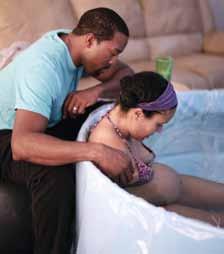
HeALtH & WeLLness
56 How Pure is your Water? Where does your water come from?
58 tired of using Harsh cleaning chemicals? Try the Norwex Alternative.












DAD’s

60 Jeff’s up to the challenge Jeff Baron is striving to win at home as a husband and a father.


Summer was glorious…Filled with trips to the beach, barbeques and the much needed family vacation off island. Now it’s time for our children to get into a more structured routine for school and with some good preparation tips you and your children can ‘Plan for Success this School Year’ have a read on page 59.

When it comes to preparing my son for school in the morning, I have a tendency to struggle with lunch ideas. It’s important to me that he not only enjoys his food (so it doesn’t return home uneaten) but that it’s healthy. If you share in this struggle, you will enjoy reading ‘Healthy Lunches’ and ‘Going Green Lunches’. You will be sure to find a few ideas (pictures included) on how to be more creative and encourage even the pickest of eaters to chow down and to be waste free. When thinking about healthy lunches Dr. Peter Perinchief discusses the one ingredient in food and beverage items all parents should be on the look out for...High Frutose Corn Syrup. Read up on why you and your kids could be addicted to this and then test your knowledge with ‘Myth or Fact’ on how healthy our children really are.

This summer we had our first Photo Submission Contest held on our Facebook page. There were three Winners of the Photo Competition each receiving a case of Harney & Sons Organic Juice sponsored by CoffeeWorks.
Congratulations to Nicola Bromby, Suzanne Khan
and Abigail Pleasant. Publisher EditorPUBLISHER & EDITOR
Katrina Ball
B USI n ESS C O n SULT an T Vic Ball
aD v ERTISI ng Sa LES
Wanda Brown
wanda0211@logic.bm
333-1925
Shawnette Smith

s-smith1980@live.com
DESI gn & PRODUCTIO n Picante Creative
W RITERS & C O n TRIBUTORS
Robyn Bardgett, Mikaela Ian Pearman, Sara Westhead, Oxford Learning, HSBC, Phoenix Kidz, Bermuda Health Council, Alicia Outerbridge, Taja Scott, Walia Ming, Marti Chiappi, Bermuda Waterworks, Tory Dodge, Mount Saint Agnes, Liza Outerbridge, Tandy Deane-Gray, La Leche League, Lisa Baumgartner, Frameworks, Consumer Affairs
O n TRIBUTI ng P HOTO g R a PHER S Becky Spencer, Jessii Terra, Langre Edwards, Sacha Blackburne
Bermuda Parent Magazine is published four times a year. Reader correspondence, photo submissions and editorial submissions are welcome. We reserve the right to edit, reject or comment editorially on all material contributed. No portion of this magazine may be reproduced without express written consent of the publisher. The opinions expressed by contributors or writers do not necessarily reflect the opinions of this magazine. Distribution of this product does not constitute an endorsement of the products or services herein.
C O n T a CT U S
info@bermudaparentmagazine.com
Tel: 504-2937
bermudaparentmagazine.com
facebook.com/bdaparentmag

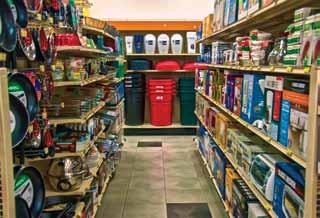


October 5
Happy 2nd Birthday
Love Mommy, Daddy and Ryan
September 9
Happy 4th Birthday!
Love Mommy, Daddy and Riana
Josh Wilson
October 4
Last year we pulled off your knight themed party… what are you going to request this year Joshua Giraffe?!?

Love, Mommy & Daddy
October 26
Happy birthday to the one and only Ryley Roo! Hope you have as much fun as you did when you turned 3.
Love, Mommy & Daddy
Shukri & As’ad
Muhammad

October 20 & August 30
Happy Birthday to our sons! With Love from Mama, Daddy and the Family!
November 19
Happy 2nd Birthday, sweet baby girl! We love you so much!!




xo Mummy, Daddy & Caiden xo”
November 18
Happy Birthday Boo Boo!

We love you!
Natalea Anderson
Jaiden Anderson
Natalea - September 9 and Jaiden - October 16
Happy birthday to our dearest angels. Mommy & Daddy are so blessed to have you & we are very proud of you. We love you so much Natalea & Jaiden! We pray that you both will continue to grow into the child of God that He wants you to become.
Lots of love from Mommy, Daddy, Nana & the rest of your family in Bermuda & the Philippines.
November 16 & November 12
Happy birthday to my special boys, may God continue to shine his light upon you. Love Mommy, Daddy, Nana Cheri and Ricyzha.


 Milena Millett
Riana Robinson
Ryan Robinson
Rickardo & Rishai Phipps
Ryley Wilson
LaShée Jones
Milena Millett
Riana Robinson
Ryan Robinson
Rickardo & Rishai Phipps
Ryley Wilson
LaShée Jones
October5
A beautiful and happy birthday to an extremely special little girl.
September 21
Happy 1st Birthday to our pride and joy... words can’t express how much we love you

October 17
Happy 6th Birthday “Smookie”... We Love you!!




October 17
We fall more in love with you every day! Happy Birthday Mommy’s little princess. Love Mommy,
November 22
Wishing you a happy 5th birthday! You are a blessing to our family. Love Daddy, Mami, Gabby and the whole family.

 Nathan Forbes
Nathan Forbes
November 8
Happy birthday with love from mommy, daddy and baby brother Jason
November 16
Happy 8th birthday Sydney! Love Mommy, Daddy and Brandon. xo


Thanks for blessing our lives with your presence. We pray for God’s blessing and anointing on your life always.
Love Momma and Dadda
September 11
Happy 9th Birthday you are growing up to be an amazing young man!
love Daddy, Mummy and Marley
Chayce RichardsonOctober 6
Happy 3rd birthday Chayce. You are all things wonderful.
Love Mummy



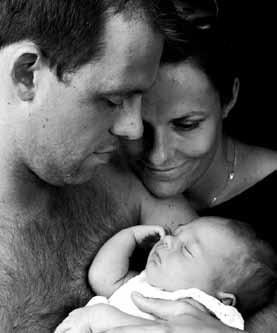





Never has arti cial avor or articial sweeteners


Toddler sized portions
Designed to develop and advance toddler feeding skills


IMPORTANT NOTICE: The World Health Organization recommends exclusive breastfeeding during the first 6 months of life and continued breastfeeding for as long as possible. As babies grow at di erent paces, health professionals should advise the mother on the appropriate time when her baby should start receiving complementary foods.



















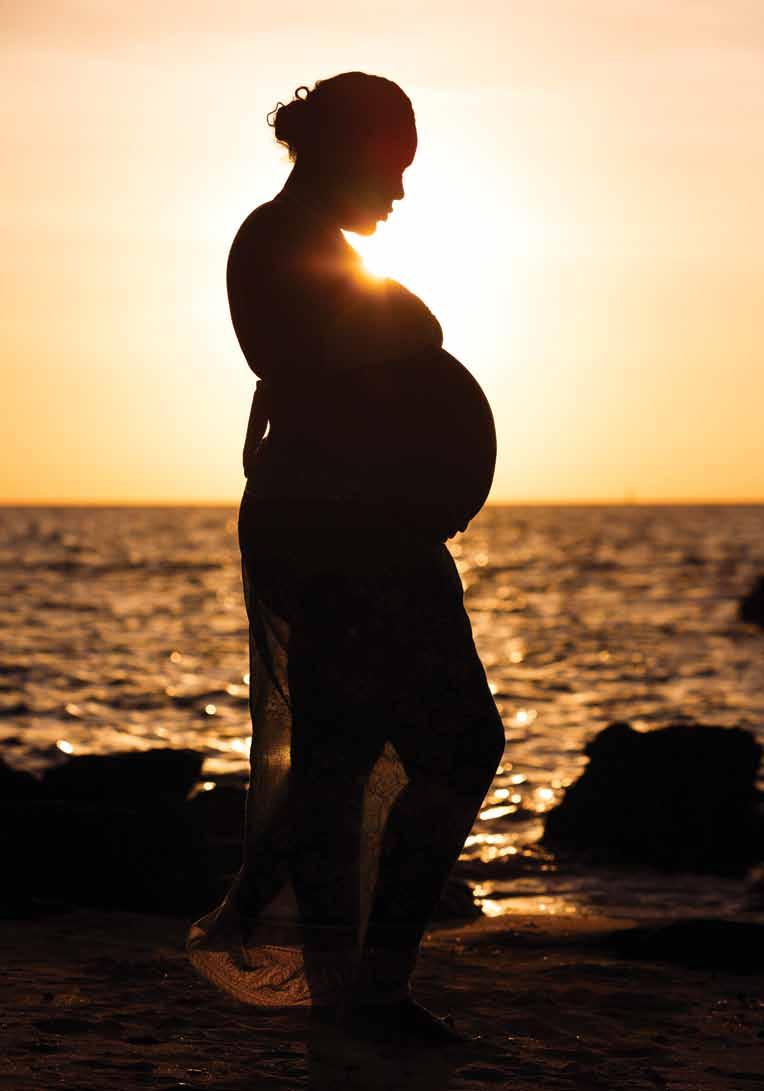
Expectant moms are all too familiar with the excitement and anticipation that comes with pregnancy and motherhood. the very act of preparing for the arrival of the baby is one of the most exhilarating times in a woman’s life. When preparing for the arrival of the baby there are so many things to do. Often confusion comes at the beginning, where to start and what to do first. From choosing clothes, to the décor of the baby’s room, the perfect stroller and eventhe decision to use disposable diapers or cloth diapers, this exciting time can quickly become expensive and overwhelming.
For first time parents, considering “what is absolutely necessary or essential”, it is often unclear and the whole experience can become confusing and daunting. Furthermore, purchasing all of the items needed for the care of the baby is costly. Fortunately, the solution to these problems is to use a baby registry this makes the overall motherhood experience as pleasant and stress free as possible.
The purpose of a baby registry is to make the purchasing process for the arrival of the new baby as smooth as possible. It can also help ease the financial burden of having a baby. While baby registries can certainly help to simplify your life, the task of selecting the right one can itself be confusing and tiring.
Therefore, when considering a registry, mothers-to-be turn to Phoenix Kidz for all of their registry needs. Phoenix Kidz boasts hundreds of extremely satisfied customers with their overall baby registry service and many parents would not hesitate to recommend their services to their friends. Phoenix Kidz specializes in baby products and has a larger range of selection compared to other local providers. They also feature a personal shopper that can help hold your hand during this overwhelming process.
The store’s incredible selection provides the convenience of one-stop shopping, and will help you, your family and friends save time and energy. Their extensive assortment of name brand merchandise includes car seats, strollers, furniture, crib bedding, breast pumps, diaper bags, toys, clothing, high chairs, feeding accessories, swings, books, DVDs, and more.
To help create a registry suited to you and your baby’s needs, Phoenix Kids offer an expert Registry Specialists available at its Reid Street store. Visit Phoenix Kidz anytime to create a new registry or update an existing one. While no appointment is necessary, you’re sure to get one-on-one assistance when you schedule a visit.


Not very long ago in terms of our history, home birth was the norm when it came to birth places of many women in our community. Home Birth in the U.K. is on the rise again but it is unlikely to reach the dizzy heights of the 1950’s and 60’s, when all but 1st births were conducted at home. The swing to hospitalization for birth within developed societies was to improve maternal and perinatal mortality. Many of these women were high risk but had no choice to go into hospital; they had to have a home birth. From what I gather, it was the more affluent members of our society (and usually low risk women) that first moved to hospital births. Yet it seems over time, women have lost the confidence in their body’s ability to birth. Fear seems to be a key factor in attitude towards birth choices. However, there are some in our community who do still believe in their ability to give birth, so much so that they may choose not to seek medical help. Through knowledge women and men can become empowered and address these fears. Women who are able to trust their bodies and ultimately defer to the medical profession for guidance through their childbearing journey.
Sadly, the move to all hospital births has led to a more medicalized approach toward birth in which pregnancy and birth are treated as a condition to be managed rather than a normal physiological process. It is impossible to remove the risk of pregnancy, labour and birth entirely, but as a practitioner of normality, it is certainly within

the Midwives role to constantly assess and seek appropriate assistance should deviation from normal occur. It takes courage to allow things to proceed as nature intended and requires the ability to tolerate uncertainty. Naturally if your stance is to control labour, unnecessary interventions are likely to be invoked because it is easier to do something rather than nothing. The statistic I have been quoted is 11%, meaning 11% of low risk healthy women will have interventions just because they walked through the hospital door. How this occurs is a well described phenomena called the cascade of intervention, a simplified example: where routine care limits movement, contractions are deemed insufficient, so these are augmented and then baby is distressed, and this ends in a caesarean.
It is very difficult to not give ‘just in case’ care, as it is difficult to stand up to those in authority or simply those in the majority as the Milgram experiments demonstrate we are more likely to conform and be compliant. This
are every day at
tendency to conformity includes the medics, midwives and the pregnant client. The nature of medical care for women is that it is difficult to refuse routine care, it is also difficult for the obstetrician as there is the potential for litigious repercussions. Some aspects of privatized care can be negotiated but they have to be asked for. This is in contrast to the Nursing and Midwifery Council UK (2004) rules which state that the role is to respect mothers as individuals, as well as their right to refuse advice.
Personal free choice with ultimate control in decision making does belong to the expectant mother/couple. This does need to be an informed choice which only occurs after lengthy discussions. Giving evidence based unbiased advice is a communication skill that means expressing ourselves clearly to meet the understanding of clients. It also means being prepared to listen and hear what you may not want to hear.

Whether learning, painting, or going on outings or playing with friends our school is a place “Where happy children learn for a brighter future”.
Bermuda’s premier early childhood education center serving parents and children ages 2-5 since 1998.
At Happy Moments we provide our students a curriculum which encourages academic excellence through creative learning as well as offering: Computer, Spanish language and Music programs.
We are currently enrolling children ages 2-3 for Spring, Summer and Fall terms 2013 at an affordable monthly tuition fee. Email:

When Cynthia and Jeremy Hassell were expecting their first child together they knew they wanted to be completely in control of the birth.
As they started researching birth classes, Cynthia says she came across information for Sophia Cannonier’s Conscious Birth Classes and decided to sign up because the material looked so professional.
“We went to the class and Sophia introduced us to the idea of home birth,” Cynthia explains.
The couple welcomed their little girl Izabella two and a half years ago in their own home going through a long and arduous labour.
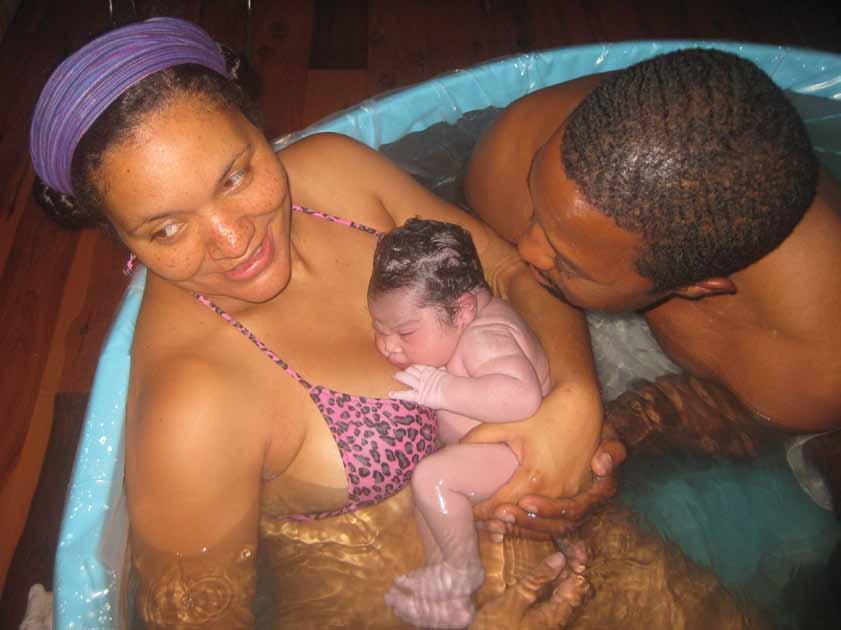
“It was very intense,” says Cynthia.
But when they found out last year that they were expecting their second child they knew they would welcome this baby in their home again.
“Nothing about that first home birth caused us to say that we wouldn’t try a home birth again. We did some debriefing after the first home birth but it wasn’t until I was pregnant with Yara that we really started talking about what we would do differently for this birth,” says Cynthia.
“I knew I didn’t want to have any interventions – no breaking water, no sweeping of my membranes. I also wanted to stand up, be more upright, as during Izabella’s birth I found myself lying down a lot, which is what I think prolonged her birth.
“It was like I was preparing for a marathon,” she adds.
After the experience of her first home birth the second birth went much more smoothly – almost quicker than they expected.
“I definitely felt more prepared as to what to expect as I had studied the Bradley Method this time around. It talked a lot about relaxation and really helped me to learn to relax. Every time I felt myself tense I would just try and get really relaxed and it helped.
“Being in your own environment really makes a big difference. You can prepare your nest the way you want – I had put up lights and had prepared a playlist of music that I wanted to listen to. Everyone caters to you and there are no shift changes. The birthing attendant is there the entire time so there is no break in rhythm. We had established a relationship with everyone before; we got to know our midwife beforehand.”
Because Cynthia was adamant that she not have any interventions when she began having consistent feelings on the morning of May 1 she decided to hold out a bit before calling on her birthing team. However, Jeremy says he had dreamt of the baby coming very quickly and having to catch her in a towel so he became concerned that they would indeed have a surprise baby.
When the contractions were three minutes long he said, he realised things were getting serious.

The couple had already met with midwife Susan Castle, who had flown down from Boston a few weeks ear-
lier so Cynthia was able to build a good relationship with her birth attendant.
“She had great energy and was very professional,” Cynthia says.
Once the birthing team assembled they didn’t have long to wait. About 15 minutes after Cynthia’s water broke, Yara was born.
“The birth team allowed my water to break naturally and I stayed upright and had the baby in the birth pool,” Cynthia says.



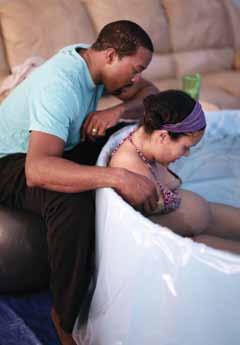
“Once Yara was here it was like a big party,” she adds. “The first few hours were important bonding time for us. She spent a lot of time on my chest and we bathed her when we were ready to bathe her. When we told people that Yara was born the first thing they wanted to know was how much she weighed but we didn’t have any clue until much later.”
The couple says they got to know the girls after each birth and took about a week after each birth to name them.
One of the biggest factors for them in choosing a home birth was having Jeremy able to stay and bond with the newest family member the entire time.

However, Cynthia says she would never attempt to “convince” someone to have a home birth.
“You have to be 100 percent invested in the process, both you and your partner,” she says. “Do the research before you give birth and understand all of your options. Understand that there are ways to have your child and it’s not out of your control.”
Did you know breastfeeding challenges can be overcome with the right support?


We offer information, support and encouragement to women choosing to breastfeed their babies. If you are pregnant or need help with nursing, contact us. Our services are free of charge and provided by skilled and accredited Leaders.

















For some, the anxiety of returning to work can be the first time they ever have considered staying at home and caring for their children.
For others, staying home to care for children isn’t practical or desirable.
No matter what, priorities change when children come into the picture.
“Returning to work now that I’m a mother didn’t really change my feelings towards work but certainly has changed my priorities,” says Yvonne DeCosta, new mom to Amelia, who was born in February. “For example, I no longer work late nights and on weekends as frequently as I had in the past. In an ideal world I would be interested in working parttime or staying at home full time.”
But that often is the issue. Flexible working hours are often not practical or available to parents. And financially, most families are unable to live off of just one income.
Yvonne, who is currently the marketing manager at Capital G, and her husband Scott, have Amelia with a home caregiver during the day.
“I was very anxious and sad to have to leave Amelia. But we did half days at first and that helped with the anxiety especially since Amelia seems to love her sitter. She smiles when she sees her and the other children – what a relief,” Yvonne says.

Robyn Bardgett states, before I had my son last year I had considered staying at home with him but I wasn’t
sure if I could hack it as a full time stay at home mom. Once Holden was born it was clear that when given the choice I was going to stay home with him – I was lucky to be afforded that option.
But while I’ve been able to see Holden grow and reach all of his milestones as well as create a significant bond with him as his main caregiver (as well as spend a lot of time at the aquarium!) staying at home does come with its challenges.
The monotony of the day to day, the diaper changes, the tantrums and baby talk can quickly turn the sharpest brain to mush. It’s hard to turn off from being “mommy” and feeling like you have a life outside of caring for a child. But looking back on the year has provided some of my proudest moments of “making it”, and has also helped to lessen my anxiety and I also believe was the reason I managed to breast feed for a year.
Yvonne lists one of the biggest challenges for her returning to work is continuing to breastfeed and having to find time to pump at work.
Ensuring that Amelia has enough milk while with the sitter during the day has also proved exhausting. Pumping, she says, can be tough, especially if a session has been missed and she has to wake up in the night to pump.
Yvonne adds: “I miss having Amelia near. Pumping is definitely not for the faint of heart but worth it for the nutritional value. I wish I had started to store (breast milk) sooner while I was still on maternity leave.”
But she says she has learned a lot since returning to work and suggests a few tips for moms to help the transition go a bit smoother:

• Start pumping and storing a month or two before returning to work. It allows you to know how much your baby drinks during feeds, and also takes pressure off mother once you’re back at work because you have a good supply.
• Be sure to confirm your schedule before returning to work with your direct supervisor.
• Be sure to confirm that you can access a safe, quiet space, with a locked door and electric outlet to pump.
• Invest in a high quality pump. Yvonne uses the Medela line because she wanted to use glass bottles.
• Medela has a good app called iBreastfeed, which is a great source of information.
• Don’t be afraid to ask for help and advice from your spouse, significant other, friends, family, doctor, La Leche League, etc.
• You’re not alone…someone has gone through what you have and there is advice out there for you.
• Use social media: Yvonne likes Raising natura l Kids on Facebook and @breastfeedingM on Twitter.
As a stay at home mom, Robyn Bardgett didn’t have to worry about being away from Holden for meals or pumping on a regular basis.

And Yvonne has seen some advantages from Amelia being in full time care.
“Amelia is learning so much from the other children at ‘school’,” she says. Yvonne says she feels Amelia has become more social. And the benefits for Yvonne include feeling like she has a life outside of being a mother.
Eventually it will be important for Holden to get to socialise more with other children. At the moment we try to make lots of playgroups and just get out and about as much as possible. One of the greatest advantages of being home has been attending the Meet-A-Mum Association (MAMA) groups. The baby playgroup that meets every Wednesday morning helped me incredibly in the beginning, and, to be honest, is beneficial even for new moms who intend to go back to work after their maternity leave is up.
While I am lucky to have a job that can be
done from home, it can be hard to schedule in time to work, especially as Holden has gotten older. It’s very rare for me to be able to get any work done during his waking hours, as little hands love a computer or he has incredible timing when it comes to screaming really loudly while I’m on the telephone. For a one-year-old it’s all about bringing the attention back to him. And, in reality, that is the reason I am home.
But it is important to schedule time away by relying on a significant other, family members or hiring some one to provide some help either around the house or to help with childcare.
For all of their challenges, either staying home or returning back to work has its advantages.
Ultimately it has to come down to what works best for a family, and in both cases building a good support system is very important to keeping your sanity.
Robyn BardgettAre you or your caregivers certified?
Are you between the ages of 12 - 16 and want to feel confident as a babysitter?


You’ve fallen in love with your newborn and have cherished every moment spent holding, cuddling, caring for and breastfeeding this precious bundle of joy. And now you have to prepare for returning to work. You may be asking yourself, “How can I manage motherhood, breastfeeding and employment?” While it may certainly be a challenge, it is also a reality for most new mothers. With some extra effort and planning ahead, you can return to work and continue nursing your baby.
In fact, many working mothers feel that breastfeeding helps them transition back to work and to manage being separated from their babies. The nursing relationship provides a source of attachment between mother and baby, despite the additional demands from work. Pediatrician Dr. William Sears says, “The most important contributor to a baby’s physical, emotional, and intellectual development is the responsiveness of the mother to the cues of her infant. It’s the attachment with your baby that counts, not just the time you spend.”
It can be wonderfully reassuring after a day at the office for a working mother to reconnect with her baby as they snuggle together and breastfeed. In many ways, breastfeeding simplifies life with a baby for a working mother. When at home, there are no bottles to prepare, disruption of sleep can be minimized, and the one-to-one attention a baby needs is practically guaranteed despite other demands of the household.
Only a mother’s milk can provide optimal nutrition and protection from illness for a baby and this is important for a working mother, as well as her employer; fewer illnesses mean a mother will have a healthier child and need less time away from work. Breastfed babies are half as likely to get sick in the first year of life as those receiving artificial baby milk.
Advanced planning will assist in making the transition back to work easier. Let your employer
know of your pumping needs in advance. This will give you a chance to develop a plan that will work for both of you. Educating your employer about the important health choice you have made will encourage cooperation.
If your employer does not provide a room for nursing mothers, consider requesting a private office or meeting room. You will benefit greatly from a location where you can relax in privacy. Although using a breast pump may seem mechanical or unnatural, remember that the milk you are extracting is a special gift that only you can provide your baby.
The frequency of your pumping sessions will depend on the total length of time you are away from your baby and the baby’s age. It’s best not to go more than three or four hours without removing milk from your breasts. As the baby gets older and begins eating solids you may not need to pump as frequently.

Since your time may be limited, using a pump that accesses both breasts is an advantage. By double pumping, mothers keep their prolactin (an important lactation hormone) level up, and they may be able to pump in only 10-15 minutes. Your expressed milk can be fed to your baby by spoon, cup, or bottle. Mothers returning to work may be tempted to introduce a bottle too soon. It is best to wait until a baby is three to four weeks; at this time, nipple confusion is less of a problem and your milk supply will be better established.
Since you will be separated from your baby while you are at work, be sure to breastfeed your baby frequently when you are home. Be prepared for more evening, nighttime, and early morning nursings.
Your baby may demonstrate “reverse cycle feeding,” changing his sleeping and feeding schedule to accommodate your absence during the day. Take this as a sign that your baby is attached to you and eagerly welcomes your return home.

Frequent nursings will also help you to maintain your supply. A mother
who plans to combine breastfeeding and working would greatly benefit from attending La Leche League (LLL) meetings. Breastfeeding mothers who are separated from their babies regularly need the support that comes from being with other nursing mothers. When you are connected with others who understand, respect, and support your career and parenting decisions, you may be surprised at what you and your baby can accomplish.
For breastfeeding assistance and support, contact LLL at 236-1120, islandgirl@northrock.bm or on Facebook at La Leche League of Bermuda.

On average, children’s products are recalled more than twice a week, that is over 100 products recalled a year. These products are recalled because they present significant safety risks to infants and young children. Recalled product information is valuable to all consumers but it is essential to parents to check the recall list often, sign up for email alerts and learn how to use the recall search function – this life saving information is available on the U.S. Consumer Product Safety Commission (CPSC) web-site.
A recall may be initiated voluntarily, when the manufacturer or supplier initiates the recall without enforcement from a U.S. federal or local government consumer protec tion agency. All other recalls are mandatory and are enforceable in Bermuda. In these cases, the U.S. Consumer Product Safety Commission (CPSC) notifies Consumer Affairs by a “Safety Alert” issued directly to Consumer Affairs’ Execu tive Officer from the District Attorney’s Office. The U.S. Consumer Product Safety Commission (CPSC) is the authority that the Bermuda Consumer Affairs references as its primary reference for recall information.
There are lots of different children’s products that get recalled, most are toys, along with car seats, infant and toddler products – cribs, strollers, high chairs etc. There are children’s products, especially cribs and bassinets that have caused deaths and have been the subject of numerous recalls.
Consumer Affairs identifies whether or not there is a possibility the item is sold locally. If the recalled item is deemed to be on the Island the manufacturer is called and details such as manufacturing dates, serial numbers and reimbursement information are gathered. Consumer Affairs will contact the local retailers to begin the process of the recall. Depending on the hazard level of the recall, products replacements or replacement parts, refunds or the removal of the product from the shelves will be carried out. Once the procedure for managing the recall is in place with each retailer, Consumer Affairs will make the recall public via a release to the press. The press release will include all pertinent details of the recall and any compensation measures that may be in place. While it is safe to say that you will unlikely purchase a new children’s product that has been the subject of a recall, you must be very careful when buying second hand children’s products. There is no expiration on recalled products and quite often these items
are sold second hand by parents who are not aware that they have either been recalled or are unsafe because of frequent use and age. Again we must stress that it is important that you check the recall list, which is on the Consumer Affairs website, before purchasing or using children’s product, especially used ones.
If you are considering using a second hand children’s product, consider the following:
• Check to ensure that the wheels are still rolling smoothly;
• Check to see if the frame is still sturdy;
• Test the stroller’s brakes;
• Look closely for any damage like sharp edges or uncovered springs;
• Verify that the stroller hasn’t been recalled by the manufacturer;

• Check the age. Strollers that are 10 years and older are not considered safe for use. The plastics used to make the stroller begin to deteriorate at this age and the model may not comply with the current safety standards or regulations such as lead testing.
Used cribs can host a variety of hidden hazards that most consumers may not detect. Thus, unless the crib can be fully assembled and operates correctly, contains all the original hardware and the instructions are included, do not buy it.

If you decide to buy a used crib, follow the checklist below.
• Make sure the crib is not the subject of a recall;
• Slats should be spaced no more than 2 3/8 inches apart;
• Make sure there are no missing or loose slats;
• Do not buy a crib with drop side (millions of cribs with drop sides have been recalled) and current standards no longer allow the manufacture and sale of drop side cribs;
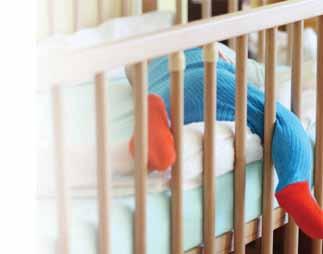
• Make sure the crib has a properly-sized mattress. The mattress is too small if you can fit more than two fingers between the edge of the mattress and the side of the crib. An infant can get his head or body wedged in the extra space and suffocate;
• Corner posts are no more than 1/16 inch high. They can be catch points for objects or clothing worn by a child and cause strangulation.
• No missing, broken or loose
hardware;
• No decorative cut-outs in the headboard or footboard. Cut-outs can entrap a child’s head; and
• No unsecured mattress support hangers that can be easily dislodged. Children can be entrapped and suffocate. Check that there are no broken or wobbly bars;
• All bolts and screws should be firmly in place and not protruding;
• The corner posts should not stick up more than 5mm. Make sure that the mattress fits the crib snugly and that there are no gaps which would allow a child to become trapped beneath it;
• Check that there are no broken or wobbly bars;
• All bolts and screws should be firmly in place and not protruding;
• The corner posts should not stick up more than 5mm.
• A wide base to stop the chair tipping.
• A five-point safety harness (shoulder straps as well as waist straps and a crotch strap) to stop the child climbing out.
• No sharp edges, or open tubes or gaps where fingers could get caught.
• The tray can be secured so the child can’t remove it.
• There should be no splits in the chair’s seat or back - a child could pick out or choke on pieces of foam padding.

• If the chair has wheels there should be brakes on at least the rear wheels.
Continued on page 31
Buying second-hand children’s products is an affordable way to equip a nursery. But it can also be dangerous as some items can be out of date and no longer safe.
Some children’s products, especially cribs and bassinets have caused deaths and have been the subject of numerous recalls. Check our website, www.ca.gov.bm before you purchase any children’s products second-hand.
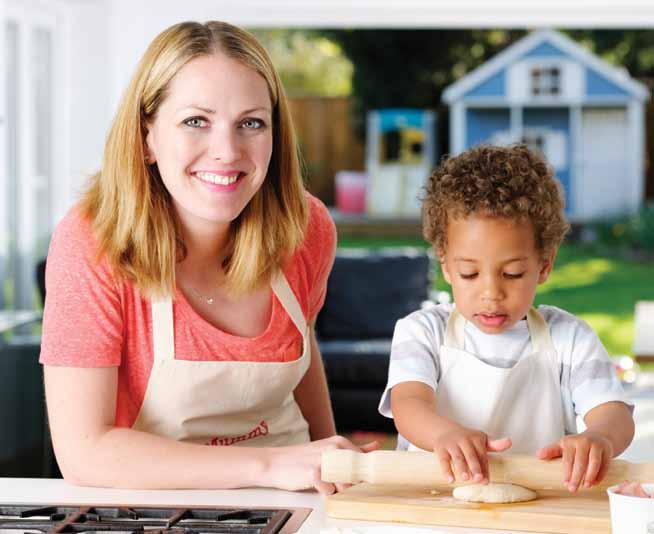








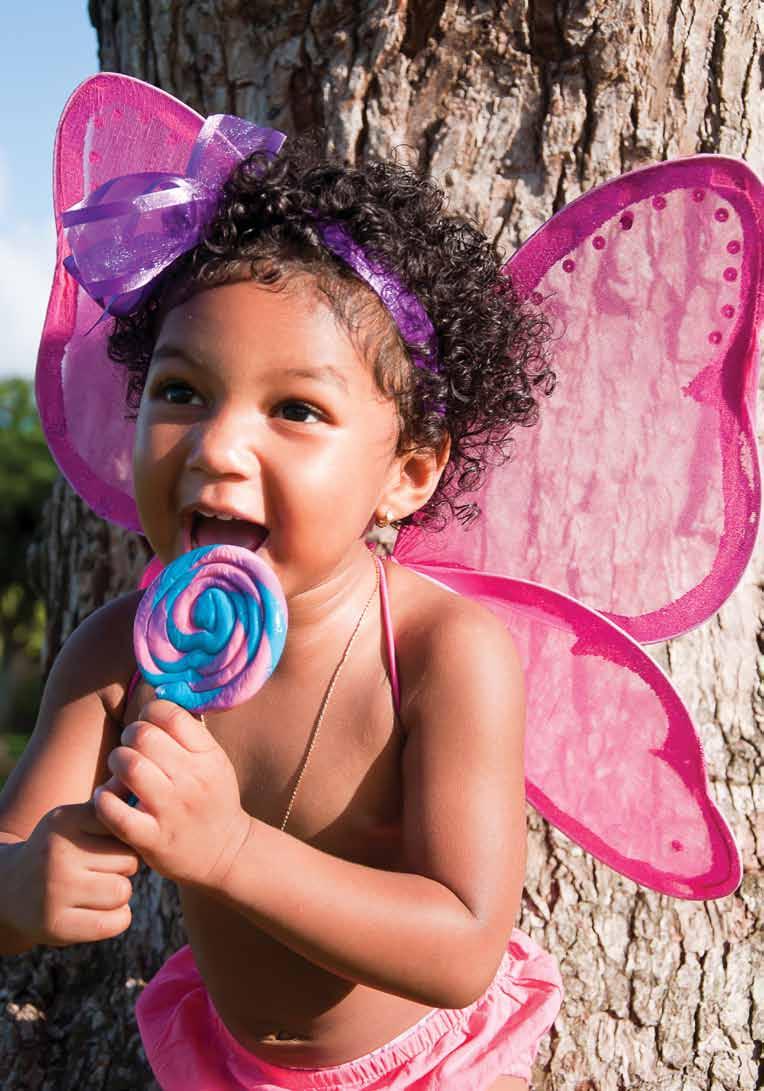


Once upon a time, when I was growing up, my life ran like clockwork. My siblings and I woke up to the sound of my father’s voice singing ‘Dippity Do-day” whilst he ruffled our heads and told us to “Rise and Shine”. I always knew when it was the weekend or a holiday, because we were not woken this way. The house was quiet and we were allowed to linger in bed for a while longer, just to reminisce, to think, to daydream.
I remember daily what was done, because they were done in the same way and time, all the time, if there was a deviation, I didn’t panic because I knew routine and order would soon return and prevail. I even learned the days of the week this way, because I knew what each day brought; Mondays were washday, Tuesdays were ironing day, Wednesdays were the day we all went to Bernard’s Park with our Dad while Mom cooked, because Wednesdays were his days off. Yes, I even knew when Thursday came, we usually went to a wedding, since back in the day, businesses gave employees Thursday afternoons off, so events like weddings and picnics were always held on Thursdays. Fridays bought extra delight as pay day and Dad always bought home special treats. Saturday was the day we visited with my cousins as our Moms would meet in Hamilton for us to go shopping together. Sundays, were filled with routines of getting dressed for Church, then us visiting family and friends
at their homes or vice-versa; I loved those Sunday afternoon gatherings and remember them so fondly. How lovely a time it was and how constant it was – I knew what to expect and anticipated it with glee.
I read somewhere that God loves constancy and guess what children do too! My parents knew it and thank God they did!

If you want chaos in your life – follow the recipe for disaster by NOT establishing routines. Routines are guidelines; directives that we all appreciate and more so when you are a child. Routines establish rhythm and bring about harmony in the family setting. Anything you do on a regular basis is a routine. The key to establishing success with routines is to keep them simple. Don’t attempt anything that is sure to present challenges later on. For instance, if you get home at 6:00 p.m. – don’t assume that you will have your child bathed, fed, read to and in bed by 6:45 p.m. You must use rationale and be reasonable in setting your routines – make routines achievable and user friendly!
Simple routines such as bath time, brushing teeth; preparing for bed, and anticipating story time are routines that children come to know and count on. Just try to deviate and you can be sure they will let you know, in fact, when I babysit my grandchildren, they tell me “Mommy does it this way!” Yes, routines are good for all concerned because they provide value to the children who count on them and find comfort in their familiarity.
To establish successful routines, here are a few basic tips:
• Keep routines simple and realistic
• Stay flexible
• Keep it personal - do what is right for you and your family
• Plan and organize – i.e. if you want dinner served on time, make sure you have all the ingredients on hand, so that you can prepare and serve dinner in a stress free manner.
Above all, remember to enjoy your children and family by keeping life as simple and stress free as possible. Happy parenting!
Recall - Continued from page 27
Bath Products
• Used baby bathtubs are fine as long as the lining isn’t full of mould or mildew. However, if the tub has an odour of either of these, stay clear of it.
• Do not use second hand bath seats, bath rings, and inflatable tubs since they have been responsible for many deaths among babies.

• In addition to mould and mildew, look for scratches or other signs of wear and tear in the plastic. Old plastics are more apt to leak chemicals and the scratches can also harbour bacteria. The Consumer Protection Act 1999 and the Sale of Goods Act 1978 (as amended 2002); have limited application to buying goods second hand. However, if you do buy from a seller who was dishonest about the reason for selling the product, you may be entitled to a refund; however compensation will have to be decided by Magistrates’ Court.
To get more lifesaving information, learn more about recalls and to sign up for ‘recall alerts’ visit the Consumer Affairs web-site, www.ca.gov. bm or visit www.cpsc.gov.
Honey Adams Bell is the education officer for Consumer Affairs.
It’s the age-old story. Parents all want to pack healthy lunches for their children to take to school, but when they do, it seems that more of it comes home than what seems to go into their stomachs.
So the question arises, how in the world do you pack a healthy lunch that your kid will actually eat?
When my youngest child started school, we certainly faced that challenge. He was so picky, that even from day to day, his tastes seemed to change. It was frustrating, to say the least. Thankfully, a dear friend introduced me to her own passion, thanks to the photos that kept appearing on her Facebook page – in order to get her own picky eaters munching away, she
had embraced the world of Bento.
While the term actually originates from China (biàndāng, meaning convenient), the concept is thoroughly Japanese – a single-portion takeout or home-packed meal, usually consisting of rice, fish or meat, and pickled or cooked vegetables in a container. And while the take-away kind are easily available throughout Japan, it is the homemade ones that certainly catch people’s attention, as they can feature favourite characters (kyraben) or pictures and scenes (oekakiben).
The concept of the Japanese bento has certainly taken hold in the West in recent years for a number of reasons, although the foods packed in them are certainly a little different (even I am

not a big fan of pickled veggies!).
One of the biggest reasons they are so popular is because, simply stated, they are environmentally friendly –reusable containers go back and forth every day without all the left over trash, plus you are saving money on not having to buy sandwich bags, or the wasting money when your buy pre-packaged, portion-sized snacks to toss in your kids lunch (which also tend to be so loaded in garbage that they are not good for you anyway).
But the other reason they are so popular is because they are fun. And when a child thinks they can ‘play’ with their food, they are far more likely to eat it. Think about it, your child won’t eat broccoli and cauliflower, but the
minute you start calling them miniature trees and brains, well what kid doesn’t think it’s cool to feel like a giant and munch on little trees, or pretend you’re a zombie eating someone’s brain?!
Also, it is so much easier to see your child’s lunch as a healthy, balanced meal when it is served on a plate (or in a bento box), because you can see that you’re providing a balanced, colourful meal, loaded with nutrients, as well as help you manage portions more easily.

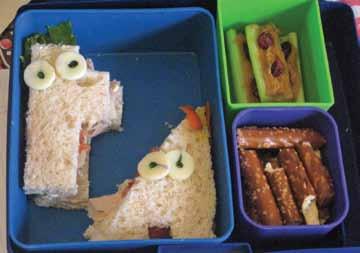

There are so many options to make lunches fun. A simple search on the internet for fun kids Bento lunches will bring you back a dizzying array of photos, websites and blogs to give you more ideas than you could ever think of. Even Disneysponsored websites like Family.com and Spoonful.com have some awesomely easy lunch ideas featuring your child’s favourite characters.
You’ll also find shops that are devoted to products that make Bento building easier, like Bento
USA (allthingsforsale.com) and Casa Bento (casabento.com).
But what does it take to make all these fancy lunches? Isn’t it going to cost me an arm and a leg to start making all these really cool lunches that will make my kids the envy of their friends and get them to eat all the things they won’t normally?
It can, that’s for sure, but it doesn’t have to. All that you really need is a traditional lunchbox with containers, or a bento-style box with dividers, as well as dedicated cutlery to send each day, and a water bottle, as well as a sharp knife and some larger plastic containers for storing things in the fridge. You may also want a good quality wide-mouthed flask, especially if your child likes hot food.
Cookie cutters can also come in handy for fun shaped sandwiches – a turtle-shaped sandwich is far more fun than a plain old sandwich, any day. I also have a stash of food-safe markers, which add a little colour when needed.
My children don’t get fancy lunches every day, that’s for sure, but rather than leaving all the work for the madness of the morning, it helps tons if you set aside a little time on a Sunday morning to pre-cut fruits and vegetables and store them in the fridge. And if you’re worried about fruit browning, sprinkle it with the juice of a citrus fruit – orange juice is sweeter than lemon!
It’s also important to know that you don’t have to go overseas to buy fun stuff for your childrens lunches – lots of shops carry all kinds of great containers, as well as accessories, especially when they stock their back-to-school items. The best places to find stuff include Gorham’s, Phoenix, Brown & Co, Lindo’s, International Imports and People’s Pharmacy, among others.
So dive on in – take the challenge! Help your kids eat more healthily, have fun while they eat and save the planet, all at the same time!
What comes to mind when you suspect your child might have a food allergy? Are there complaints of tummy upset, hives, itching or does breathing become difficult? All of these can be symptoms of food allergies. There are two different types of food allergies. The first is known as Type 1 or fixed which can be life threatening if the offending food is not avoided. “Fixed” food allergies can come from the ingestion of fish, peanuts, and shellfish. The second is known as Type 2 or delayed which is the most common type of food allergy people may experience. “Delayed” food allergies can come from the ingestion of foods such as eggs, yeast, milk, wheat and corn. Food allergies can develop for a variety of reasons.
Food Allergies are being diagnosed more frequently due to increased allergy testing. Persons with compromised immune systems can be at an increased risk for developing a food allergy. Genetics can also play a significant role in whether or not a child will develop food allergies that are particular to the family. There are no recommendations at this time to avoid foods while breastfeeding to prevent allergies.
When you are concerned about your child’s food allergy follow these easy tips to help with creating a food allergy free environment:
H Both parent and child should meet with a Registered Dietitian: Registered Dietitians can help both parent and child to understand which foods are safe to eat and the best way to avoid items that may cause a reaction. Dietitians can educate both parent and child about good nutrition needed for growth and health. Dietitian’s can also help with planning menus.

H Educate child about the foods they should avoid and substitute those foods with those similar in nutritional content: Provide a list of food ingredients to be avoided. Do not rely fully on lists of “safe” prepackaged foods because ingredients may change making the lists out-of-date quickly.
H Teach children to read the labels on packaging: Manufacturers can change ingredients of products without notice so checking ingredient food labels carefully for every food item being served is very important. Sometimes ingredients that are not expected to be present in a particular type of food can be included and will cause an allergic reaction.
An example of this was when a child, allergic to legumes, (beans, soy, and peanuts) had an allergic reaction to a cheese pizza she had eaten. The ingredients were listed but she was unaware that the manufacturer put beans in the crust to increase protein content. Please see some common foods label
items according to allergies www.foodallergy.org/document. doc?id=133.
H Develop and teach your child about specific cleaning procedures: Making sure that tables and surrounding areas are thoroughly cleaned before and after preparation of food is very important. A specific area should be designated where allergy- free meals can be prepared and served. It is important that a specific cleaning cloth is used for the allergy- free tables to avoid cross contact.

H Those who are not affected by allergies tend to be less inclined to accommodate or take food allergies seriously: Do not be afraid and teach your child to ask questions when dining out regarding the preparation of a food item. If possible call the restaurant in advance to request specific food preparations.

H Inform child’s school about allergies and adverse reactions: Ensure that the school nurse is aware and can provide training to staff in regards to specific medical procedures that are to be followed in the case of an emergency. Teach your child not to share or exchange utensils, food, snacks, or beverages.
H Create and discover new recipes: Do this by using ingredients that are non allergenic. Developing your own cook book is a great way to experiment with different ingredients with your child.

Your child has presented you with their ‘masterpiece’ - perhaps something drawn in art class or on a rainy afternoon at home. You love it and it deserves a better spot than stuck on the

fridge or hung on a bulletin board. It needs to be framed! You have just had a family photo shoot done perhaps by a professional and the results are amazing. These photographs need to be

framed! Framing, a daunting prospect? No, you need the services of an expert designer, one who will listen to your ideas and wishes and guide you through methods of framing so that your beloved piece of art will be protected for years to come.

Framing your new piece of art is very personal. This is where we excel: Frameworks’ designers will guide you as to which design, style, colour, treatment and frame will enhance your piece of art.
Think about the surface or background of the final hanging place for your art. The goal is compatibility. There should be some contrast between the wall and the frame so the piece pops rather than disappears – for example a white frame looks stunning on a coloured background, but fades to insignificance on a white wall. You need to set the stage for your new acquisition. You want a frame to enhance the subject as well as the décor of a room. Consider the use, style and size of the room you have chosen to hang your artwork, the piece should flow with the surroundings. If a room location for hanging has not been selected, then use a frame that will fit in with your general decor style, rather than a specific room style.
Frameworks offers a large variety of custom mouldings and, in there, is the
perfect frame for your little one’s masterpiece. We have fun, bright colours, solid colours, silvers & golds and even some frames with a bit of glitter! The type of frame you use on your child’s art could be a reflection of their personality. We have framed some child art in outlandish gold frames to suit dynamic personalities as well as that formal dining room it will hang in!

If custom framing is a little too much for the pocket book, we offer a selection of affordable ready made frames that are very popular with child art. A popular alternative to full framing with glass, is to have your child’s art mounted onto board and laminated, we use a lovely matte finish laminate and will advise if this process is suitable for your piece.
Family photographs are memories to be cherished forever. A good quality print is always recommended. It is quite


popular and stylish at the moment to have your photographs transferred to a canvas. Frameworks can stretch your canvas piece for hanging on the wall. Canvas is durable in this climate and cost efficient.
If you have a paper photograph it is recommended to mat the photograph with a nicely proportioned mat, this not only enhances your photo, but helps prevent it from sticking to the glass, which, in Bermuda’s climate is a common problem. Chose a frame that will suit the subject. If you have several images it can be tricky choosing your favourite one, in which case you might want to do them all! We can help you collage together appropriate images into one frame or help you make your own ‘Rogues Gallery’ choosing a fun mixture of frames and mat colours.
Frameworks can help you with any project and we love a challenge! We
frame Christening gowns, baby shoes, first onesies, first blankets, children artwork, canvases, needlework, prints and posters.
Visit us in the Paget Plaza, 163 South Shore Road, Paget, so we can help you preserve your precious memories. Check out our new website www.frameworks.bm and like our Facebook page for tips on framing and other useful information.

• Play-based screenings for 24 – 30 month old children

• Parent and Children’s Book Library
• Toy Library
ALSO AVAILABLE:
• Parent Infant Group
• Premature Infant Programme
PArEntIng wOrkShOPS:
• 1,2,3,4 Parents!
• 1,2,3 Magic

tOPICS AVAILABLE:
• Motor Development
• Developmentally Appropriate Programming

• Bonding: Early Steps to Attachment
• Behaviour Management
• Language Learning


















Fructose has had a lot of very bad press and with justifiable reason. glucose on the other hand, is its chemical ‘non-identical’ twin and is essential to life. every cell in our body with a few exceptions uses it as a primary fuel. this is not the case with fructose.
Fructose does not exist alone in nature. It is chemically bound up with Glucose to form Sucrose (Table Sugar) so it is only 50% of the total apparent caloric content of sugar. Fructose makes foods and drinks sweeter to the taste. In the 1970’s Governments decided that fat was bad and mandated that the fat content of our food had to be reduced. Unfortunately, low fat food is much less palatable. To solve this problem, the food and beverage industry added corn syrup to processed foods (over 500,000 of them) in order to make them tastier. Corn syrup is now the main sweetening agent in North America and Bermuda
A kernel of corn contains mostly corn starch and this material is the source of corn syrup. Corn starch is made up of Glucose molecules strung together like beads on a string. Fructose is completely absent. Manufacturer’s break down the corn starch to free up the glucose molecules and then add an enzyme that converts the Glucose into Fructose at the desired concentration (10-90%). The result is much sweeter (and

far cheaper) than cane sugar and is produced by the ton on a daily basis. The ‘High Fructose Corn Syrup’ is then added to anything that needs an extra bit of sweetness, for example, tomato ketchup, breakfast cereals, juice and soda. Start to check your food and drink ingredient labels and see for yourselves.
Furthermore, fructose dulls or does not send signals to the brain of being satisfied or full. It appears that after consuming ‘high fructose corn syrup’ it does not produce a sense of satisfaction and unlike glucose, it fails to apply the hunger brakes and could be considered as a form of sugar addiction. We are now consuming fructose in quantities that nature never intended. This increase of fructose consumption goes beyond what our body’s liver is programmed to process. Research is showing that our livers cannot cope with the fructose onslaught that we are delivering. The high volume of fructose begins to behave in a toxic fashion, producing a fatty liver, and inflammatory chemicals which contributes to Metabolic Syndrome and Type 2 Diabetes. These two

conditions alone are increasing at alarming rates and are currently poised to bankrupt the financing of public and private medical funding. This dismal prognosis is made even more pronounced as these diseases are appearing at younger ages than ever before. This should be reason enough to avoid giving infants, children and teens any food or beverage products that contain high fructose corn syrup of any kind.
The list of food and beverage products containing high fructose corn syrup or corn syrup is enormous. It behooves us as adults to thoroughly read the ingredients and seriously consider what we put into our mouths and then teach children the importance of considering what goes into their mouths. Consuming corn syrup of any kind is simply like grabbing a bag of useless calories that are not being burned as fuel through vigorous activity, but rather, being stored as fat under the skin and around the internal organs causing other complications.
The epidemic of obesity in pre-schoolers and excessive weight gain in toddlers and infants can be directly attributed to the sugar content of their diets and a less physically active lifestyle. An entire generation must battle obesity because of consuming extra corn syrup calories
lifestyle. This will likely continue as governments lack the political will-power to impose restrictions (particularly where the sugar additives are concerned) as to what is added to food and beverage products.
Avoidance of commercial juices and related products should be a primary objective for all parents and the little ones should to be dissuaded from consuming a soda along with a McHefty burger and the trimmings. A good education while children are growing up might help long-term toward having a healthier adulthood.
Neonatal Care
General Pediatric Care (Birth to 21yrs)


Routine Immunizations
School Physicals and Adolescent Care

No Referrals Needed a dult Service S

Internal Medicine Consultations
Specializing in Chronic Disease Management: Diabetes, High Blood Pressure, High Cholesterol
Specializing in Obesity and Weight-Loss Management
Adult Appointments by Referral only
As busy parents, we have come to depend on the many convenience products that are now available to us, and nowhere is that more evident than when we shop for our children’s lunches. The easiest, and often the least expensive lunch box items are sold in single-use, disposable packages. Admittedly, these items are very convenient, but what is the environmental cost of consuming single-use items in such vast quantities? By making a commitment to packing waste-free lunches, not
only will you be decreasing the amount of trash you use, you will be teaching your child important eco-considerate habits for life.
A waste-free lunch replaces disposable bags, plastic wrap, foil, single-use cartons, pouches, cans and paper towels with reusable containers, reusable cutlery, and cloth napkins.
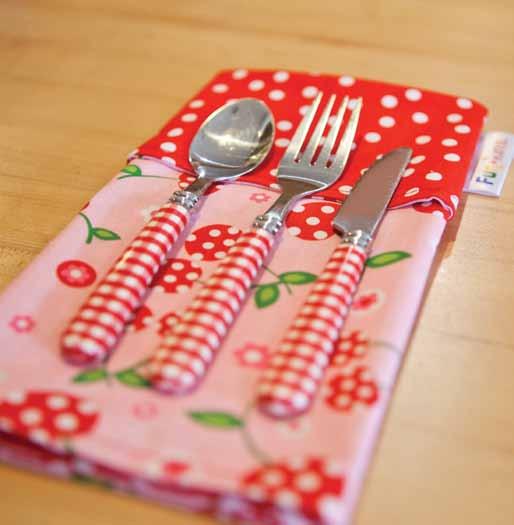
Packing a waste-free lunch is easier than you think, and these ideas are great for school, work, travel, and play!
1. Invest in a reusable lunch bag. Replace toss-away paper or plastic bags with a reusable lunch bag or box.
2. Use only reusable food and drink containers and cutlery. Juice boxes are the most inorganic trash and retain their weight, volume and form for at least four decades. Stainless steel, glass or BPA free plastic containers are much better options.
3. Switch to cloth napkins. The number of tissues and paper napkins going into landfills worldwide is staggering – landfills are full and overflowing, with paper waste being a leading contributor. Cloth napkins are easy to wash in with the regular laundry – a simple replacement with a big impact. Also, paper comes from trees, so, quite simply, the fewer trees we use, the better it is for our earth.
Implement and encourage all of your families and co-workers to follow a waste-free lunch policy. The idea is to educate our communities about where the trash ends up, and what we can do to reduce the amount of trash that we generate. Remember, every little bit counts and while recycling is great, reusing is even better. Teaching our children through the examples we set is key.
Mom-Tip: In our home, we spend time together Sunday mornings washing and preparing our fruits, veggies and snacks for the week. We put them into reusable containers, which make getting lunches ready each morning quicker and easier. When the kids are involved in preparing their lunches, there is a greater the likelihood they are going to eat everything in their lunch boxes while at school.
For more information on waste-free lunches, how to start a waste-free lunch program at your school or office, fundraisers, and for information on cloth versus paper napkins, please visit myfunkins.com.
Bermuda mom, Lisa Baumgartner, is the Founder & CEO of MyFunkins Ltd., manufacturer of award-winning Funkins cloth napkins for kids. Lisa@myfunkins.com
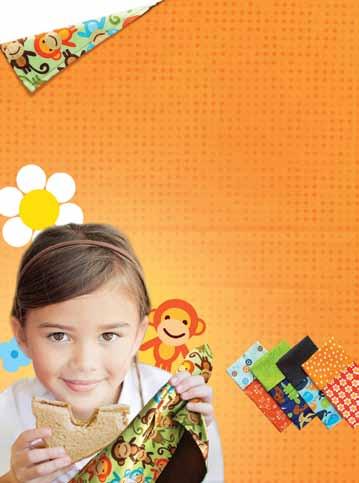

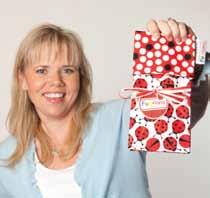
With the number of boarding schools in the USA, Canada and the UK totaling in the hundreds, a parent may rest assured that there is one or more perfect schools for their child. It is not a matter of fitting the child to the school, but the opposite, the school must be the right fit for the child. With so many schools to choose from, it can be a daunting task for parents to know which one would meet their child’s needs, interests and personality. An educational consultant can be of great assistance in finding and choosing the right one.
When parents enlist the help of a consultant, the first priority is to learn as much as possible about the child. How are they doing in school, what are the child’s strengths or weaknesses academically and socially and importantly, what are the parents’ hopes and expectations.
We must remember that boarding school isn’t the answer for everyone. In my experience, if a student who has no history of behavioral or medical issues, does not want to go away to school even after they have been told how great it will be and have visited, then

Madeira is an independent American boarding and day school for girls in grades 9–12. Located just 15 miles from The White House, Madeira combines the serenity of a 376-acre campus with the fast pace of one of the world’s great capital cities. As juniors, Madeira students serve as interns for members of the U.S. Congress.
Explore our exemplary Co-Curriculum program and take the virtual tour at www.madeira.org.

they shouldn’t. The idea is to send a child TO school not AWAY to school. This is an incredible opportunity and it should be seen as that.
So what makes a school a good fit? To find the answer one must ask this question: What does one school provide that will better instruct, support, challenge, encourage, protect and importantly compliment the child compared to another?
Where to start? The first step to solving this puzzle is for the consultant to gather and reflect on the information given from the parents, school reports, teachers’ comments and any academic testing that is available. The next step is to consider not only the academic fit for the child but also what that particular child wants. What are they excited about? Do they like academics over sports? Are they enthusiastic about going or not yet convinced? Was this their idea or their parents? What country do they want to go to? Do they like cold weather? And so on.
Educational Consultants exist to assist families in making the best school choice. The goal is to find the school that benefits your child’s learning style,




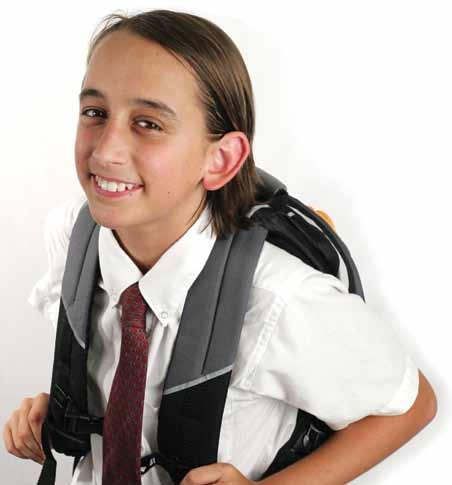
in order to provide an effective educational environment and prepares them for the future. Together as a team, we can do the job of finding an environment where the children are happy, confident and well prepared for the challenges that life will present them.
Tory Dodge Educational Consultant: Schools to Know will be in Bermuda from September 23 to October 12. Her annual school fairs are on Sept. 26 & 27 and Oct. 9 & 10 at the Hamilton Princess Hotel. More information on the services of an educational consultant and on the schools fairs can be obtained by contacting Tory on her

Since the advent of compulsory school education, Britain’s schools have remained world leaders and sit at the top of every international ‘league table’ of schools that is published. This picture is made even sharper when examining Britain’s independent schools: without question they remain among the most successful and best known in the world. They managed to swell their numbers by 2% during a severe economic crisis and remain one of the UK’s greatest ‘imports’, they continue to outpace their state school counterparts – and their model is so successful that other countries across the globe have sought to replicate it in their own private schools.
So, why should Bermuda families consider sending their children to school in the UK?
Britain’s independent boarding schools are internationally renowned, with names such as Eton, Harrow and Winchester being as well known as the Queen. To attend a school with such global clout undoubtedly gives young men and women a fantastic head start.

The UK still ranks 5th in international league tables of schools, well ahead of Canada (10th) and the USA (17th). This academic excellence is even more pronounced in independent schools where, through outstanding teaching and small class sizes, examination results are impressive. In 2012, 31% of all independent school entries at GCSE were
awarded an A* (national average 7.3%); at A-Level, 18% of entries received an A* (national average 7.9%).
At Sixth Form level, Britain’s independent schools offer the choice of either A-Level or the International Baccalaureate. This choice caters for pupils of all abilities and interests, and these qualifications are internationally recognised and transferrable.

4.
Britain has 2,500 independent schools –catering for pupils of academic abilities. Therefore, it is much easier to find a school that will be able to play to your child’s strengths, rather than having a much more comprehensive intake. Independent schools’ examination results speak volumes to how successfully they nurture all talents: 12.7% of all independent school pupils receive some form of SEN support.
The academic, sporting and boarding facilities in Britain’s independent schools are the finest in the country – so much so that many of them were used for the London 2012 Olympics. The range of extra-curricular activities available at independent schools is unrivalled.
6.
A Bermuda pupil should find the transition to school in the UK seamless. Not only is the curriculum and culture the same – in middle school, GCSE and IB – but there also no cumbersome visa restrictions or formalities.

Bermuda is an idyllic place in which to grow up but there comes a time when the island’s size and tranquil isolation means that it is beneficial for young men and women to be exposed to the world around them. Britain’s history, culture and tradition are intertwined with that of Bermuda whilst having Europe is on its doorstep
Nothing prepares a young man or woman for university and life better than the structured independence of boarding school. Confidence building, camaraderie and courtesy are central to boarding schools’ ethos. The standard of boarding school accommodation is now so high and the pastoral care so home-like that many pupils choose rarely to go home at all!

Now that Bermuda students can attend British universities at the ‘home student’ rate of fees, never has the UK been so attractive. Independent schools’ success rate at Oxbridge and Russell Group entry is unparalleled and the fact that UK qualifications are internationally recognised means that 44% of leavers attending non-British universities still achieve places at leading US universities.

The majority of Britain’s politicians, businessmen, music and Hollywood stars attended independent schools. Your child might one day sit among this hall of fame…
A number of the UK’s leading independent schools will be attending the British Schools Fair Bermuda, on 25th & 26th September, in the Hamilton Princess Hotel.

Working together to develop the whole child. At Mount Saint Agnes Academy (MSA) we recognize children as individuals and encourage them to develop according to their potential in order to become responsible, contributing members of a complex and ever changing world.

Our smaller class sizes encourage interactive learning with teachers focusing on individual learning styles and promoting critical thinking and problem solving skills. The combination of MSA’s world class curriculum, daily infusion of Catholic values and the expertise of our dedicated Faculty and Staff ensures that your child receives the most complete education available in Bermuda.

We welcome prospective families and are pleased to provide personal tours at your convenience. Our goal is to aid you in discovering whether MSA is right for your child. Come and see for yourself what MSA has to offer, not only in our classrooms, but also on our playing fields, gymnasium and labs. As you do, you will begin to understand why our graduates love MSA and go on to make remarkable contributions in a broad range of personal and professional endeavors. Application forms can be obtained from the MSA website at www.msa.bm or by contacting the School Office.
19 Dundonald Street West Hamilton HM 09, Bermuda Telephone: 441-292-4134 Email: msaoffice@msa.bm www.msa.bm
As the only Catholic school in Bermuda, MSA is dedicated to offering a “faith-based, values-added education”. Whether Roman Catholic or not, the infusion of faith-based learning into the daily lives of our students further strengthens their foundation of personal development.
At MSA, we are pleased to offer the Alberta, Canada Program of Studies at all grade levels as the basis of our learning facility. We are the only school in Bermuda to offer a continuous curriculum from kindergarten to senior year of high school with class sizes less than 20 students.
MSA’s program of studies provides a balanced curriculum encompassing a wide variety of choices and learning opportunities. Our program is individualized and student-centered, with course choices designed to meet the academic and vocational goals of each student.
At MSA we provide differentiated learning opportunities in all subject areas. By differentiating their instruction and assessment procedures, teachers provide all students with opportunities to experience success.

At MSA we deliver a world-class curriculum, which ensures our students acquire the qualifications necessary to pursue higher education and the career option of their choice. The opportunity for a Work Experience program provides exposure and hands-on experience within a chosen career path while earning the student credit toward their diploma.
6 7 8 9 10
At MSA, technology is a tool used to enhance learning, communication, achievement, imagination and academic efficiency. The use of technology is not intended to stand alone, but rather to be infused within core courses and programs.
MSA teachers are dedicated professionals who are certified by both the Bermuda Educators Council and Alberta Education and are experienced in their respective fields. Teachers and administrators work together to ensure that every student has confidence in their learning.
At MSA we want parents to have an active role in their child’s education. There are many opportunities for parents to connect with the school through teacher conferences, information sessions, career planning meetings, and parent seminars. We celebrate the importance of family involvement with special masses and invite family attendance at all of our many prayer services and assemblies.
MSA is ideally located in the City of Hamilton situated in an enclosed secured campus. Over the past few years, the teaching and learning spaces of the school have undergone upgrades and renovations in order to meet the demands of the 21st century learner.
1 2 3 4 5 BY MsA 49 www.bermudaparentmagazine.com









Parents today, encounter more challenges and difficulties than ever before in determining what role technology should play in their children’s lives. Social media sites, web-enabled devices, web-enabled video games and iPods surround and influence our children from a very young age. Trying to manage your house to be tech-free can be quite difficult when you hear the ‘but-everyone-else-has-one’ argument.
Like any aspect of the internet there are pros and cons to social networking sites. The fact is that parents of tweens and teens should be aware of the pros and cons in order to protect their family.
New social networking sites are introduced constantly and banning your children from being part of the social media craze is not the solution. The tools tweens and teens use to engage, gives them the opportunity to enjoy friendship and activities online. Social networking sites like Instagram, Facebook, and Twitter can be fun and positive for your tweens and teens, but must be used in moderation.
For Marisa Stones, Senior Analyst for the Department of E-Commerce, who specializes in providing tips for online safety at Cybertips.bm, thinks that the overall
“There are many issues that are associated with and often exacerbated by social media use.”
Cyberbullying is one such issue associated with social media that parents should seek to prevent. Unfortunately, technology does not allow for the person being bullied to avoid the bully, as in the traditional form of face-to-face bullying. Cyberbullying can often be exacerbated outside of the home causing a situation to worsen when it could be avoided.
Mrs. Stones believes parents should talk with their children about what to do in a cyberbullying situation even before it happens. Tell your children to not respond to a message from a bully, save the message as evidence, and talk to a trusted adult about the situation.

This can keep the bully from ever doing this again because cyberbullying is illegal in Bermuda and can be presented before the courts, if the issue gets out of hand.
If you are the parent of adolescents or teens, you must be aware of, in control of and teach the value of online etiquette. Most social networking sites, such as Facebook, have privacy settings and age standards to become a user. While, most parents are aware of the settings and preferences provided, the tween/teen is not so familiar and this could lead to poor representation of their image. Parents can prevent children from the short term and long term effects of social media by increasing privacy settings and discussing the importance of managing their online image.

Mrs. Stones believes the best way for tweens and teens to understand how powerful social media and the internet is, “is to pull up their favourite search engine and type in their name to see what comes up. As they get older, schools and companies may search their names – whether such actions are considered fair or not, it does happen and therefore it is best if there is nothing online that presents a negative representation of the person.”
Consider the following pros and cons from Mrs. Stones to help you make appropriate decisions on how to keep yourself and your children safe on social networking sites.
Pros:
a teaching tool. Your child can benefit from learning new media skills giving them the opportunity to be interestdriven in online activities.
access information that interest you instantly. When you pick up your mobile device to view your Facebook timeline or surf the web, you’re able to see what interests you right at your fingertips.
Learning to balance life. Having social media sites can help one to manage and pritoritze personal, work and digital life. You’re able to control what you want to appear online verses being able to control what happens around you.
You can see and understand different opinions. Everyone has an opinion about society and its changes. Being able to access it over social networking sites can help understand the opinion of others.
Capitvating audience. You are able to share and educate others on a topic or area that is of interest to you.
cons:
Can be distracting or obessive. Your teen/tweens can easily be distracted or become obsessed with technology and can lose focus on school work and other outside activities. As they do not yet have the tools to manage appropriately.
It encourages narcissistic behaviors. Research shows that Facebook, Twitter and other networking sites can encourage narcissistic behaviors. This can cause personality issues because interacting with friends on social media is different from interacting with friends in real-life.
Social media can foster anxiety, depression and vulnerabilities. Children who interact (only) through social media show a severe lack of social skills. This causes depression and vulnerability because they are unable to communicate with those around them.
Social media has consequences. It’s easy to express yourself to friends and family through posts on social media, but posting the wrong thing at the wrong time can affect their image. It’s an avenue for gossip and rumors. Parents should make their teens aware of what should and should not be posted if they want to avoid rumors and gossip. Peers can be cruel and will discuss your personal life if you give them the option.
Social media has a tremendous effect on society today, but with parental guidance and childrens’ cooperation, the effects can be positive for everyone.
“There are many issues that are associated with and often exacerbated by social media use.”BY BerMuDA HeALtH cOunciL
Bermuda’s children and adolescents are returning to school to reinvigorate their minds, but how is their health? In 2006, The Health Survey of adults and Children in Bermuda was completed by the Department of Health (DoH) and in 2011, the Bermuda Health Council (BHeC) and the DOH collaborated on Health in Review, which compared Bermuda’s health to countries of the Organization for Economic Cooperation and Development (OECD). These reports, among others, have assisted BHeC with dispelling some common beliefs, and providing new information, about the country’s children. Here BHeC highlights some of those results.
1. Myth: children always seem to be sick.
Fact: Bermuda’s children are pretty healthy. The Health Survey of Adults and Children 2006 asked parents about specific medical conditions their children (0-10 year-olds) had in the previous year. The rates found were similar to the US for on some indicators, like asthma attacks (Bermuda 10%, US 12%), and no school days missed due to illness (Bermuda 27%, US 29%). But Bermuda’s figures were better for other health problems, such as respiratory allergies (Bermuda 9%, US 20%), and learning disabilities (Bermuda 5%, US 10%).

2. Myth: Bermuda must do very well when it comes to vaccinations for children.
Fact: Actually our results are mixed on this front. Vaccination rates for pertussis (whooping cough) (96%), tetanus (96%)
and polio (96%) under 1 year of age have been consistently high and well above the OECD average. However, vaccination rates for measles and hepatitis B are lower than the OECD average – 89% and 83% respectively vs. 92% and 95% for OECD. The incidence of hepatitis B infections (4.7%), are also higher than the OECD average (2.7%).
3. Myth: everyone takes their child to the emergency room for care.
Fact: Most children don’t use the emergency room (ER). In 2006, 24% of parents said they’d taken their child to the ER at least once in the previous year. However, most parents don’t do so for regular healthcare; most take their children to a paediatrician (80%), a general practitioner (9%) or a health centre (7%). Only 4% took their children to the ER for health
advice and, surprisingly, the majority were in the middle income bracket.
4. Myth: children’s teeth must be falling apart from all the candy they eat.
Fact: Despite the candy, Bermuda’s children have very healthy teeth. Health in Review found the average number of decayed, missing or filled teeth for 12-year-old children was well below the OECD average. Our low rates are due to excellent prevention measures, like regular check-ups, and population-wide oral screening, sealant and fluoride programmes.
5. Myth: My child’s healthcare is not subsidised
Fact: All of Bermuda’s families benefit from child subsidy. Government provides patient subsidies for hospitalization for specific populations: Youth (children below school-leaving age), Seniors (80% coverage for 65 to 74-year-olds and 90% coverage for 75+), Indigent and Geriatric (Continuing Care Unit utilization by any age group). In 2011, the total cost of the youth subsidy was more than $16 million. Families benefit from this even if their child is not hospitalized because that coverage is not included in their insurance premium. That portion of the premium (currently $325.84) is paid by Government.
6. Bermuda’s children are hooked on tV.
Sorry but this is not a myth: Bermuda’s children do watch too much TV. According to parents’ self-reports, 36% of children watch more than one hour of television a day; of those, 18% watch more than two hours daily.
7. Myth: television is harmless fun for children
Fact: Watching too much TV is harmful for children’s health. International studies have found that excessive exposure to television and videos (viewing time) is associated with impaired childhood development and childhood obesity. In 2001, the American Academy of
Pediatrics recommended no more than 1 to 2 hours of “quality programming” per day. Bermuda’s 2006 health survey confirmed that, locally, TV affects a child’s weight too. Children who watch less TV are more likely to be normal weight and children who watched more than two hours of TV a day were more likely to be overweight or obese.
8. Myth: Our children are big boned not overweight
Fact: A third of children and a fifth of teenagers are overweight or obese. More than 30% of Bermuda’s children under 10 are overweight or obese, though less than 10% of parents believe them to be. For teens, 19% are overweight or obese1, compared to 14% in the OECD; Bermuda’s teen rate is exceeded only by Canada (21%) and the US (30%).

9. Myth: children don’t eat breakfast daily
Fact: Most children do. According to parental reports in 2006, 95% of children eat breakfast every day. This doesn’t diminish the harm to the 5% who eat breakfast less than seven days a week, and the rate may well have gone up since 2006. However, the data available indicates that most families do the right thing for their kids in this regard.

10. Myth: Bermuda’s infant mortality is very low
Fact: Not quite. In 2007 Bermuda’s infant mortality (child deaths in the first year of life) was 4.7 per thousand, compared to the OECD average of 3.9. With Bermuda’s small population year on year fluctuations can make a big difference, but with three consecutive years of increased infant deaths, the trend cannot be ignored. Particularly when, in prior periods, Bermuda ranked among the best-performing countries on this allimportant indicator of healthcare quality and access.
For access to the reports mentioned in the article please visit the Bermuda Health Council’s Publications’ page on our website: www.bhec.bm.
Copyright © 2013 Bermuda Health Council

Bermuda Waterworks manufactures bottled water under the Pure Water brand. Bottled water is a healthy, convenient, food product that residents use because of its refreshing taste and it is a good way to stay hydrated. It is a healthy alternative to other beverages in helping to combat the obesity epidemic.
In these changing economic times consumers are becoming more price conscious. The best deal for bottled water can be found at the Pure Water Customer Service Desk at 32 Parsons Lane, Devonshire. Household clients can save $3 per 5 gallon bottle if they collect at our Plant versus delivery. This savings applies to purchases paid via cash, debit cards, credit cards and cheques. Not only is water a precious resource in Bermuda but so is your wallet.
Bottled water in reusable containers has been going green long before it became popular. Our bottles can be reused several times, once our customers do their part. Bottles are rejected if there are any leaks or if they have been contaminated with other liquids e.g. drink mix or dirty bottles. Very often schools and organizations have coin drives or other fundraising activities. The company is quite happy to donate reject bottles to these events. Just give us a call and save a good bottle from going bad.
Bermuda Waterworks is also a leading provider of piped drinking water. Daily we supply water to homes, businesses, hotels and cruise ships. In Bermuda water is a valued resource. In the absence of natural rivers, the settlers constructed tanks for water catchment and storage. It is a practice that is carried out to this day. Necessity was the mother of invention for our forefathers and they excelled in their ingenuity. Early in our company’s history, brackish water was the order of the day. Several decades later we are using advanced Reverse Osmosis and Desalination techniques to extract and treat our source water. Approximately two thirds of our piped water comes from treated sea water. The remaining one third comes from desalting brackish ground water extracted from the underground lens. The abundance of sea water has made Reverse Osmosis a natural fit for the company’s operations. The piped water supply is chlorinated after rigorous treatment so that it meets local and international quality standards.
In 2010 Bermuda Waterworks entered into an agreement with the Bermuda Government to expand its distribution to the western part of the island. The second phase up to Somerset Bridge has been completed and clients are already benefitting from the new water service. The long term goal is to extend the pipeline into Somerset Village. Pipeline extension in the Spanish Point area was started this summer and will be an ongoing project. These various expansions will help to alleviate the temporary crisis that can result from a long period of dry weather.
The cost of the company’s piped water is quite competitive. A truck load of water now costs $90 on average




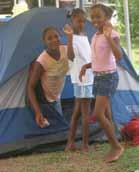
and holds 1000 Imperial gallons. Bermuda Waterworks’ base rate is $24.74 once the early payment discount is applied. This entitles the customer to 1000 Imperial gallons of water. In these changing economic times, not having a piped water connection in an area that we serve is an unnecessary expense on the household budget.


For the last 80 years, Bermuda Waterworks has manufactured water to meet the island’s growing needs. Our daily mission is to provide the island with a high- quality potable piped drinking water supply and internationally approved bottled water products. We are here to meet all of your water needs.


Bottled water in reusable containers has been going green long before it became popular.
On our beautiful Island where mold and mildew abound, many are plagued with asthma, bronchitis and Chronic Obstructive Pulmonary Disease (COPD). These ailments can be life threatening. There is nothing more frightening than to hear a child gasping for breath or hearing them wheeze. For these sufferers, it is critical to control the mold and mildew as well as drastically reduce the exposure to chemicals.
There are many ‘green’ products
on the market, but if you read their labels, they contain chemicals, thus not chemical free as they allude to. Alternatively, if they contain no chemicals (or very little), they are ineffective in their performance as advertised, yet have paid more!
Norwex will not only clean as it claims, Norwex back up their products with 100% satisfaction guarantee! You will not get this with any over-the-counter products. Norwex’s MISSION is: “Improving quality of life by radically reducing the use of chemicals in personal care and cleaning”
From cleaning ceiling fans to floors and everything in between, nothing cleans like NORWEX!! So, what are these products? To just to name a few: -
Microfibre clothes: Each is weaved with threads that are 1/200th the size of a human hair! The clothes will pick up the most miniscule particle of dirt, but where other microfiber clothes fail, these will also germs, bacteria, salmonella, etc. The clothes are imbedded with Antibac micro silver which self-purifies against mold, fungi and bacteria odor within 24 hours! Swedish lab tests show 99% bacteria reduction on smooth surfaces! No other product does this. Because of the silver, ONLY WATER is used with these cloths.
Microfibre mop: Cleans floors without leaving streaks. Two styles to chose
from, the Antibac wet pad or the Tile wet pad (tile mop is not Antibac).



Mattress Cleaner: Dust mites thrive in Bermuda’s moist, warm climate. Using the Mattress Cleaner will eradicate not only the dust mites, but their feces which we breathe into our lungs continuously causing reactions such as watery eyes, runny noses, chest congestion and allergy symptoms. We often blame allergies and take medications when it’s not allergies at all that is causing the symptoms.
Ultra Plus Laundry Detergent: Did you know that commercially sold detergents (regardless if power or liquid) are ¼ to 2/3rd fillers? Fillers add volume without adding quality to the product. An example of what fillers are made from – ground whale bones, peanut shells, dry wall, etc. Norwex detergent is 100% pure soap, NO fillers, NO perfumes, low suds so works well in standard washers as well as high efficiency machines as well.
Come and hear about these and other amazing products. Demos will be held each Saturday morning at 11:00a.m. SHARP at ATLAS HOME IMPROVEMENT, 16 Wallers Point Road, South Side, St. David’s, Bldg unit 13A/B. If you know where Big Saving’s Zone is, turn west (right) until you reach the last units.
Contact Marti Chiappa at mrc@logic. bm or 336-6833.
It’s back to school time again. in order to head back to school geared up for learning, it is necessary to get the cognitive wheels turning as soon as possible.
Mentally preparing to head back to the classroom is especially important after a summer spent by the pool or beach, mornings spent sleeping in, and afternoons spent on the soccer field. The sooner that children get ready to learn, the easier the transition to the classroom will be.
Summer schedules are greatly different from the structured academic-style schedule that students encounter at school. Transitioning between the two can be difficult for students. Kids can spend up to two months (TWO months!) simply adjusting to academic schedules—sitting at a desk, taking notes, listening to the teacher—rather than jumping into learning from day one.
The first weeks of school are a critical time. Children who begin a new school year ready to learn from day one have a considerable advantage over students who spend the first month or so reviewing and merely getting up to speed. There are a few things that can be done during the early days of school (and even in summer) to help make the transition back to the classroom smoother for all students.
• Reinforce the use of a day planner to record daily homework assignments, deadlines, after-school activities, and upcoming quizzes and tests. Consider using an agenda during the summer to keep track of social activities, chore times, bed times, and team sports—it’s a great habit that benefits students all year round.

• Keep set bedtimes and morning routines. If your child doesn’t have an alarm clock, the summer is a great time to introduce one. Implement wake up times and morning routines so when the first day of school rolls around, your child will be ready to roll out of bed—no rushing required.

• Start homework, even before it’s assigned. Don’t wait for the teacher to send homework home to get into the habit of hitting the books after school. Begin making it a habit to review the day’s notes, organize the book bag and binder, and prepare for the next day. In the summer, students can write in a journal or read a book.
• Meet with your child’s teacher and get to know the upcoming grades’ schoolwork and activities. Ask about reading lists or special projects that may be assigned.
The early days of the school year may not be homeworkintense, so why not use this time to get ahead in some reading?
• Have a quiet place to study at home that is free from distractions. Keep reference materials, books, dictionaries, encyclopedias, and school supplies such as calculators, pens and pencils nearby.
The earlier that families begin to implement solid back to school routines, the easier the transition into the classroom will be. Good back to school routines lead to a successful school year.
For more information on how to make this back-to-school season a success contact Oxford Learning Bermuda at 441 296-6060; Bermuda@oxfordlearning.com
This year will be the year that I no longer have to worry about test scores, project marks, or report card grades. This year will be the year that it all makes sense. This year I’ll get A’s. This year I’m going to Oxford Learning.
Oxford Learning...your partner in education Pre-KtoGrade12 Reading Writing Math TimeManagement StudySkills Homework Grammar
Pre-KtoGrade12 Reading Writing Math TimeManagement StudySkills Homework Grammar
It was a hard-fought battle that brought Jeff Baron to the forefront when he stepped up as a candidate for the One Bermuda Alliance last year. And while he may have lost the election to serve as an MP, the now senator and national security spokesman for the OBA is learning to win at home as a husband and father.

“Politics plays a huge part of my life now – I stop and talk to everybody and want to learn about the issues in relation to public safety,” Senator Baron explained, and his time was even more consumed by it leading up to the election. “I left my house three times a week and all day Saturdays and Sundays, and I realized I didn’t spend enough time with my own family.”
Jeff is the proud father of Jackson, or Jack as he’s better known. “He’s a boy through and through. He’s got a great sensibility about him as well; he’s very reflective.”
However, even though he is still very young – he only turned four at the beginning of the summer – the time Jeff was spending away from him was beginning to take its toll. “What he needed was someone to watch ‘Jake and the Neverland Pirates’ with, to read his books with. That’s the lesson I’ve learned – you don’t need to oscillate between being a politician and a father. You have to be both and both compliment each other.” Making Bermuda a better place for Jack is also a key motivator for Jeff in his political motivations. Particularly in the realm of national security and gang violence, but also in helping the community not only know they are safe, but feel safe too. “Bermuda can turn things around. People are beginning to feel safer, feel more optimistic. I don’t believe we’re on this downward spiral, but this is tough. If I didn’t, I don’t think I would have put my son through this. I do this because he’s four and I want him to say someday, ‘This is what my dad did’.”
Even with all his experience, as a police officer, member of the SWAT team, serving as a field officer with the United Nations peacekeeping forces in Kosovo, and having a masters degree in criminology, Senator Baron realizes parents and
families need to make the time to make a difference in the lives of their young people. “It’s very attractive for many kids to look at the gang lifestyle – it’s attractive, its feasible, and it provides them with a meaningful life.” Having spoken with many young men who have found themselves in gangs, he understands why these young people dive into the gang lifestyle, especially when you hear their stories. “It’s rational for them to seek out love and validation for criminal acts. Kids are seeking these very basic emotions.”
“Parents, grandparents, aunts – who is influencing your son? Who is influencing your daughter? Is it YouTube? Is it family? Is it gang members? This is a complete community effort – we can’t just lock people up and expect it to go away. We need moral voices to come out and say it is wrong, we care, and that it needs to change.” Being a part of the government and the political wheel at a time like this – with changes such as the amendment to the Human Rights Act –are certainly exciting, but it is fatherhood that makes it worth the hard work. “But what makes those types of things special are things like, my son reading his first book by himself. It enriches my life and helps me think why its worthwhile risking my emotional life. It’s tremendous validation as a father. He values the time we spend together…The joy I get out of being a father, nothing pleases me more. I put the highest value on being a father – I know how important it is and how high the stakes are.”
The Department of Parks is informing the general public that as of the 1st November 2013, the 1988 Bermuda National Park Regulations have changed regarding dogs and horses on the public beaches, under the jurisdiction of the 1986 Bermuda national Parks act.

Dogs are permitted to be on the public beaches until the 31st March 2014.
The dogs must be on a leash at all times.
During this period until the 30th april 2013 horses are nOT permitted on the following beaches at any time:
1. John Smith’s Bay Park
2. Elbow Beach Park
3. Horseshoe Bay Beach ( South Shore Park )
The Department of Parks is informing the general public that as of the 1st November 2012, the 1988 Bermuda National Park Regulations have changed regarding dogs and horses on the public beaches, under the jurisdiction of the 1986 Bermuda National Parks Act.


The cooperation of dog kennel operators, and the owners of dogs, in abiding by the regulations, is greatly appreciated.
Dogs are permitted to be on the public beaches until the 31st March 2013.
The dogs must be on a leash at all times.
During this period until the 30th April 2013 horses are NOT permitted on the following beaches at any time:
1. John Smith’s Bay Park
2. Elbow Beach Park
3. Horseshoe Bay Beach ( South Shore Park )
The cooperation of dog kennel operators, and the owners of dogs, in abiding by the regulations, is greatly appreciated.
6. No person shall, being the owner of,or in control of, a dog –
6. No person shall, being the owner of, or in control of, a dog –
(a) subject to paragraph (b), bring such dog unleashed on to any protected area; or
(a) subject to paragraph (b), bring such dog unleashed on to any protected area; or
(b) bring such dog on to any public beach in a protected area during the period from the 1st April to the 31st October in any year; or
(b) bring such dog on to any public beach in a protected area during the period from the 1st April to the 31st October in any year; or
(c) subject to paragraph (b), bring such dog on to any protected area using a leash greater than three meters in length, or
(c) subject to paragraph (b), bring such dog on to any protected area using a leash greater than three meters in length, or
(d) cause, permit or suffer such dog to annoy or disturb any person in any protected area.
(d) cause, permit or suffer such dog to annoy or disturb any person in any protected area.
1. (1) Subject to paragraph (2), no person shall, in any protected area
(a) take a horse other than on designated roadways or trails; (b) ride a horse in a manner likely to cause danger to any person therein;
(c) ride a horse at a speed greater than fifteen kilometers per hour;
1. (1) Subject to paragraph (2), no person shall, in any protected area
(d) being in control of a horse leave the horse unattended when it is not properly tied to some suitable object, other than a tree or shrub;
(a) take a horse other than on designated roadways or trails;
(e) lead from horse-back a riderless horse which is not appropriately bridled;
(b) ride a horse in a manner likely to cause danger to any person therein;
(f) lunge or break in any horse;
(c) ride a horse at a speed greater than fifteen kilometers per hour;
(g) ride a horse in excess of a slow walk when passing in the vicinity of other members of the public using the area.
(d) being in control of a horse leave the horse unattended when it is not properly tied to some suitable object, other than a tree or shrub;
In exercise of the powers conferred upon the Minister by section 25 of the Bermuda National parks Act 1986, the following regulations are hereby made: -
(e) lead from horse-back a riderless horse which is not appropriately bridled;
amendment of BR 49/1988
(f) lunge or break in any horse;
5 (2) During the period –
(g) ride a horse in excess of a slow walk when passing in the vicinity of other members of the public using the area.
(a) 1st November to 30th April in any year no person shall take or ride a horse on Horseshoe Bay, John Smith’s Bay and Elbow Beach but may take or ride a horse on all other public beaches below the high water mark at any time;
In exercise of the powers conferred upon the Minister by section 25 of the Bermuda National parks Act 1986, the following regulations are hereby made: -
Amendment of BR 49/1988
5 (2) During the period –
(b) 1st May to 31st October in any year no person shall take or ride a horse on Horseshoe Bay, Johns Smith’s Bay, Elbow Beach and Shelly Bay but may take or ride a horse on all other public beaches below the high water mark between the hours or 5:00 a.m. and 8:00 a.m.
Also by signs and notice: No dogs in the Main Show Ring at Botanical Gardens and no dogs in Coopers Island Nature Reserve.
Also by signs and notice: no dogs in the Main Show Ring at Botanical gardens and no dogs in Coopers Island nature Reserve.
(a) 1st November to 30th April in any year no person shall take or ride a horse on Horseshoe Bay, John Smith’s Bay and Elbow Beach but may take or ride a horse on all other public beaches below the high water mark at any time;
(b) 1st May to 31st October in any year no person shall take or ride a horse on Horseshoe Bay, Johns Smith’s
Che-Chulae Dowling is clearly one of the most talented up and coming stars in Bermuda. At the tender age of 8, Che–Chulae has excelled at track and field for Bermuda Pacers, field hockey, soccer, softball and horseback riding. She was most recently awarded the Bermuda Equestrian Federation Junior Champion in Equitation for the Under 8 Category 2013. Even with all these sports under her belt, she still has time for her favorite pass time, modeling!
Che-Chulae took part in the Evolution Fashion show this past July and competed in New York’s Top Kid Model.
Che-Chulae was invited by the producers of Top Kid Model to try out for the show for a chance to win the coveted title of Top Kid Model. The video that drew the attention of the producers can be seen on YouTube with over 9300 views.
Top Kid Model is a reality show featuring children from around the world, all competing for the opportunity to win a modeling contract with the lead children’s modeling agency Willamena Philadelphia.

Che-Chulae is a young girl doing big things on our island. Watch her video on YouTube entitled, ‘Top Model Kid Bermuda’; we think you would agree that Che-Chulae Dowling is a Rising Star.
Che-Chulae states, “There is no mountain that is too tall for me to climb! I can do all things with God by my side!”
Placement in Children’s classes are by AUDITION only (call/email for an appointment)
Ages 4-9 years
Call today to book your Audition and to Register. 296-5900 Email sophiacannonier@gmail.com for information on Scheduling an Audition, fees, uniform and class availability. Location:
September 9-December 16, 2013
No classes:
October 28- November 1
(Half Term Classical Ballet Camp)
November 11 (Public holiday)
Class times:
Mondays 3:45-5pm Level: Primary C
Tuesdays 3:45-5pm Level:Primary A/B
Also offering ADULT Ballet classes
Thursdays 6:30-7:30pm

The Family Festival of Sail will take place to kick off the Argo Gold Cup schedule, on Sunday, October 6th and will be held at Barr’s Bay Park, adjacent to the Royal Bermuda Yacht Club. There will be fun castles, live entertainment, free face painting, games interesting displays about early Bermuda sailors and pilots, and food stalls available at the park for a day of fun for the entire family.



To introduce the joys of sailing to those who attend, three J 105 yachts have been provided and will take adults and children accompanied by a guardian out on 30-minute sails around Hamilton Harbor. During the harbor sail the skippers of the yachts will point out the Gold Cup regatta and explain the significance of the event to Bermuda. Children between the ages of 10 and 15 years old will have the opportunity to sail around the harbor with an experienced youth sailor under the guidance of a professional sailing instructor. There are also free boat rides in a rigid inflatable boat to zoom through the harbor.
The Festival of Sail has become a solid feature of the Argo Gold Cup which couldn’t happen without the generous sponsors. The Festival adds excitement and vibrancy to the Gold Cup event and encourages Bermudian sailors to continue to develop their skills to international standards.
Parents, mark your calendars for this great festival to entertain your young children and teens alike.









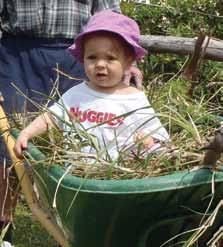










adventureland nursery & Preschool
45 Middle Rd. Warwick WK 05
Tel: 238-8032 or 238-0208
Email: ros.nursery@ibl.bm
Enroll Now! Exciting center-based, fully equipped facility. Quality, caring teachers with CPR and first aid. Spacious classes and playground. Creative thematic curriculum, computers, “kinder-musik” music program, optional dance and Spanish, field trips, summer swimming program. 18 months –5 years. 7:45 a.m. – 5:30 p.m.
Bermuda School of Music
23 Berkeley Rd. Pembroke HM 11 Tel: 296-5100
Email: musicschool@northrock.bm
Web: www.musicschool.bm
The Bermuda School of Music, a registered Bermuda charity #483, has been providing music education to the Island since 1978. It is our aim to provide community music programs for students of all ages. The school’s faculty offer instruction in piano, voice, organ, guitar, percussion, woodwind and all stringed instruments.
Bermuda Underwater Exploration Institute (BUEI)
40 Crow Lane, East Broadway, Pembroke HM 19
Tel: 292-7219
Email: info@buei.org
Web: www. buei.org
Happy Moments nursery & Preschool
69 North Shore Rd. Hamilton Parish
Tel: 737-8385
Email: happymoments123@yahoo.com
Happy Faces, Happy Learning, Happy Future… Where your child’s day begins with God’s blessings! Bermuda’s premier early childhood educational center, ‘Where quality education remains affordable.’ Academics places an emphasis on language, computer and music program(s). Ages 2–4.
aerie’s adventures
Tel: 799-1504
Email: aeriesadventures@hotmail.com
Aerie’s Adventures caters to children between the ages of 2-5. Our curriculum is based on traditional and hands on philosophies. It includes, field trips, music, spanish, morning devotions and family events. We gave qualified teachers, who love, encourage and inspire their students.
Bermuda School of Russian Ballet
P.O. Box HM 661, Hamilton HM CX
Tel: 293-4147 / 295-8621 or Studio 292-2192
Email: info@balletbermuda.bm
Web: www.balletbermuda.bm
DanceSations
Tel: 335-3271
Email: missholly@dancesations.bm
Web: www.dancesations.bm
to be listed in our directory in the magazine and on our website, contact us at info@bermudaparentmagazine.com
mother support and encouragement for breastfeeding, as well as the latest, evidencebased medical information. Our work is provided without charge by skilled, accredited leaders. We offer monthly support group meetings, an email and telephone hotline, and an extensive lending library.
Care@Home Services
Tel: 295-2273
Email: care@myhome.bm
Web: www.care-at-home.info
DanceSations is a program with structure incorporating many different aspects of a dance program while keeping it fun and entertaining. Students learn self-discipline, concentration, self-confidence, the value of teamwork and an appreciation of the arts. We are just as excited as the children to host a program that allows them to creatively explore the fine arts.
Visit www.bermudaparentmagazine.com for more info.
Bermuda Cancer & Health Centre
46 Point Finger Rd.
Paget DV 04
Tel: 236-1001
Web: www.chc.bm
A specialist approach to patient care. Call us today.
Baby Boot Camp
Tel: 441-537-5370
E-mail: elinor@babybootcamp.com
FB: www.facebook.com/ babybootcampbermuda
Web: www.balancedfitness.bm
Baby Boot Camp Bermuda is a 60minute fitness class for mom and baby. Baby Boot Camp caters to all fitness levels: pregnant moms, new moms recovering from pregnancy and conditioned moms with stroller-aged children. Cardio drills and strength training exercises increase overall fitness and give a total body workout!
La Leche League of Bermuda
Tel: 236-1120
Email: islandgirl@northrock.bm
La Leche League of Bermuda is a registered charity that provides mother-to-
Care@Home Services provides personal in-home care solutions (nannies and housekeepers) to Bermuda resident families. Trusted. Experienced. Caring.
Sugar Rush Cakes
Tel: 337-6171
Email: sugarrushbda@yahoo.com
Web: sugarrushbermuda.com
Bermuda Linens & gifts
16 Water Street, St. Georges
Tel: 296-0189
Web: www.bermudalinens.com
At Bermuda Linens & Gifts, there are big ideas for little ones … and big values for you, the customer. With attention to detail and design flair, you will find trendy baby gifts, baby accessories and so much more! Add great packaging and free gift wrapping for a one-stop shopping experience.
Frameworks Ltd.
163 South Shore Road
Paget DV 04
Tel: 236-6082
Email: frameworks@northrock.bm
Web: www.frameworks.bm
Frameworks can help you preserve your most precious memories, framing anything from jerseys to posters. We have a selection of affordable ready made frames and specialize in preservation custom framing.
norwex Enviro Products
Tel: 296-6833 or 336-6833
Email: mrc@logic.bm
Norwex Microfiber Cloths … there’s no other cloth like it! Norwex has developed a unique technology that combines an antibacterial silver-based agent with our microfiber. The antibacterial agent is actually embedded inside the tiny microfiber. It destroys the bacteria that it picks up in its fibers.
Bring your family closer with a Digicel Family Plan. Share your voice, SMS and data amongst 2-5 people and save. Plans start as low as $65 a month. Visit a Digicel store today.

Don’t make your fridge too cold and always use the energy-saver setting Maintain according to manufacturer’s instructions If you have a fridge or freezer that is not fully used, unplug it or dispose of it

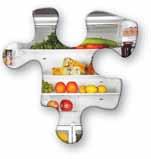

Water heaters use a lot of electricity Setting them no higher than 120° F, or according to manufacturer’s instructions, will save money and be ample for your dishwasher, washing machine and shower When travelling, unplug your home water heater


T imers on water heaters can save hundreds of dollars a year T imers also save energy when used with other appliances, lighting and electronic items

Air conditioning can make energy bills soar Turning the AC on when you come home and off when you leave costs less than leaving the AC running continually You don’t use energy when the air conditioner is off Choose fans and open windows when you can
The bigger the TV screen, the more energy is used Some TVs consume more energy than others LEDs are the most energy efficient, while plasma TVs are energy hogs
Even when electronics are turned off, they still use energy in standby mode, drawing “phantom load”. Put electronics on power strips and turn off the strips Turn off lights and TVs when you leave rooms When you travel, unplug everything possible at home


A big energy saver is the small bulb Switch to light-emitting diode (LED) or compact fluorescent lightbulbs (CFLs) They last a long time and suit most applications


i ve ovens cook ckly and with atively little nergy Toaster vens use less nergy than ull-size ovens nd produce s heat Use lids ots and pans to p n, and use the smallest pot and burner
se dishwashers, washing machines and ryers only when they are full, and use the hortest, coolest or most energy-efficient settings










Appliances with the Energy Star label use less energy, save money and help protect the environment When buying home appliances or electronics, choose highly rated Energy Star models






Put the pieces together to save energy, money and the environment.







